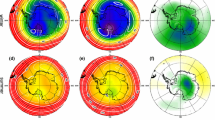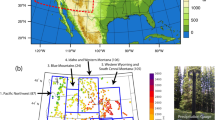Abstract
We present results from numerical experiments made with a GCM, the NCAR CCM1, that were designed to estimate the annual balance between snow-fall accumulation and ablation for geographically important land regions for a variety of conditions. We also attempt to assess the reliability of these results by investigating model sensitivity to changes in prescribed physical parameters. Experiments were run with an initial imposition of 1 m of (midwinter) snowcover over all northern hemisphere land points. Over Alaska, western Canada, Siberia, and the Tibetan Plateau the model tended to retain this snow cover through the summer and in some cases increase its depth as well. We define these regions as “glaciation sensitive” and note some correspondence between them and source regions for the Pleistocene ice sheets. An experiment with greatly reduced CO2 (100 ppm) showed a tendency towards “spontaneous” glaciation, i.e., the model remained snow-covered throughout the summer over the same geographic regions noted above. With 200 ppm CO2 (roughly equal to values at the last glacial maximum), snow cover over these regions did not quite survive the summer on a consistent basis. Combining 200 ppm CO2 and 1 m of initial northern hemisphere snow cover yielded glaciation-sensitive conditions, agreeing remarkably well with locations undergoing glaciation during the Pleistocene. To assess the reliability of these results, we have determined minimal model uncertainty by varying two of the empirical coefficients in the model within physically plausible ranges. In one case surface roughness of all ocean gridpoints was reduced by an order of magnitude, leading to local 10% reductions in precipitation (snowfall), a change hard to distinguish from inherent model variability. In the other case, the fraction of a land grid square assumed to be occupied by snow cover for albedo purposes was varied from one-half to unity. Large changes occurred in the degree of summer melting, and in some cases the sign of the net balance changed as fractional snow cover was changed. We conclude that the model may be able to reveal regions sensitive to glaciation, but that it cannot yield a reliable quantitative computation of the magnitude of the net snow accumulation that can be implicitly or explicitly integrated through time.
Similar content being viewed by others
References
Andrews JT (1982) On the reconstruction of Pleistocene ice sheets: a review. Quat Sci Rev 1: 1–30
Barnett TP, Dümenil L, Schlese U, Roeckner E, Latit M (1989) The effect of Eurasian snowcover on regional and global climate variations. J Atmos Sci 46: 661–685
Barnola JM, Raynaud D, Korotkevich YS, Lorius C (1987) Vostok ice core provides 160 000 year record of atmospheric carbon dioxide. Nature 329: 408–414
Blackmon ML (1986) Building, testing, and using a general circulation model. In: Wilebrand J, Anderson DLT (eds) Large-scale transport processes in oceans and atmospheres. Reidel, Dordrecht, pp 1–70
Broccoli AJ, Manabe S (1987) The influence of continental ice, atmospheric CO2, and land albedo on the climate of the last glacial maximum. Climate Dynamics 1: 87–99
Budyko MI (1956) Heat balance of the Earth's surface. Gidrometeoizdat, Leningrad
Curry RR (1969) Holocene climatic and glacial history of the central Sierra Nevada, California. In: Schumm SA, Braley WC (eds) United States Contributions to Quaternary Research (Geological Society of America Special Paper 123), pp 1–40
Denton GH, Hughes TJ (eds) (1981) The last great ice sheets. Wiley, New York
Fastook JL, Chapman JE (1989) A map-plane finite-element model: three modeling experiments. J Glaciology 35: 48, 52
Flint RF (1971) Glacial and quaternary geology. Wiley, New York
Gates WL (1976) The numerical simulation of ice-age climate with a global general circulation model. J Atmos Sci 33: 1944–1873
Hansen J, Lacis A, Rind D, Russell G, Stone P, Fung I, Ruedy R, Lerner J (1984) Climate sensitivity: analysis of feedback mechanisms. In: Hansen JE, Takahashi T (eds) Climate processes and climate sensitivity Geophys Monogr Ser 29; AGU, Washington DC, pp 130–163
Holloway JL Jr, Manabe S (1971) Simulation of climate by a global general circulation model. 1. Hydrologic cycle and heat balance. Mon Weather Rev 99: 335–370
Kiehl JT, Wolski RJ, Briegleb BP, Ramanathan V (1987) Documentation of radiation and cloud routines in the NCAR Community Climate Model (CCMI). NCAR technical note. NCAR/TN-288 + IA, Boulder
Kuhle M (1988) Subtropical mountain and highland-glaciation as ice age triggers and the waning of the glacial periods in the Pleistocene. Geo J 14: 393–421
Kuz'min PP (1972) Melting of snowcover (Protcess Tayoniya Shezhnogo Pokrova) (translated from Russian). Israel Program for Scientific Translations, Jerusalem
Kutzbach JE, Guetter PJ (1986) The influence of changing orbital parameters and surface boundary conditions on climate simulations for the past 18000 years. J Atmos Sci 43: 1726–1759
Leavesly GH, Stannard CG (1989) A distributed-parameter, energy-budget, snowmelt and runoff model for basin-wide applications. EOS, Transactions, American Geophysical Union 70: 1109
Levitus S (1982) Climatological atlas of the world ocean. NOAA Professional Paper 13:173 pp
Male DH (1980) The seasonal snowcover. In: Colbeck SC (ed) Dynamics of snow and ice masses. Academic Press, New York, pp 305–396
Manabe S (1969) Climate and ocean circulation. 1. The atmosphere circulation and the hydrology of the earth's surface. Mon Weather Rev 97: 739–773
Manabe S, Wetherald RT (1975) The effects of doubling the CO2 concentration on a general circulation model. J Atmos Sci 32: 3–15
Manabe S, Wetherald RT (1980) On the distribution of climate change resulting from an increase in the CO2 content of the atmosphere. J Atmos Sci 37: 99–118
Manabe S, Wetherald RT (1985) CO2 and hydrology. In: Manabe S (ed) Issues in atmospheric and ocean modeling. Part A. Climate dynamics (Advances in Geophysics, 28). Academic Press, Orlando, pp 131–158
Marshall SE (1989) A physical parameterization of snow albedo for climate models. Ph D Thesis, University of Colorado, Boulder
Munn RE (1966) Descriptive micrometeorology. Advances in Geophysics (Suppl 1). Academic Press, New York
Neeman BU, Ohring G, Joseph JJ (1988) The Milankovitch theory and climate sensitivity. 1. Equilibrium climate model solutions for the present surface condition. J Geophys Res 93: 11153–11174
Neftel A, Oeschger H, Schwander J, Stauffer B, Zumbrunn R (1982) Ice core sample measurements give atmospheric carbon dioxide content during the past 40000 years. Nature 295: 220–223
Oglesby RJ (1989) A GCM study of Antarctic glaciation. Climate Dynamics 3: 135–156
Oglesby RJ (1990) The application of equilibrium climate models to questions of glaciation at high latitudes. Ph D Dissertation, Yale University (available from University Microfilms, Ann Arbor, Michigan)
Oglesby RJ, Saltzman B (1990) Sensitivity of the equilibrium surface temperature of a GCM to systematic changes in atmospheric carbon dioxide. Geopyhs Res Lett 17: 1089–1092
Oke TR (1978) Boundary layer climates. Methuen, London
Peixoto JP, Oort AH (1983) The atmospheric branch of the hydrologic cycle and climate. In: Street-Perrot A, Beran M, Ratcliffe R (eds) Variations in the global water budget. Reidel, Dordrecht, pp 5–65
Pitcher EJ, Malone RC, Ramanathan V, Blackmon ML, Puri K, Bourke W (1983) January and July simulations with a spectral general circulation model. J Atmos Sci 40: 580–604
Prentice M, Matthews RK (1988) Cenozoic ice-volume history: development of a composite oxygen isotope record. Geology 16: 963–966
Prentice M, Fastook JL, Oglesby RJ (1989) Behavior of the Antarctic ice sheet during early Pliocene warm-earth climates: a combined ice sheet and atmospheric model study. International Glaciological Society: Symposium on Ice and Climate, Seattle, August 1989
Ramanathan V, Lian MS, Cess RD (1979) Increased atmospheric CO2: zonal and seasonal estimates of the effects on the radiation energy balance and surface temperature. J Geophys Res 84: 4949–4958
Ramanathan V, Pitcher EJ, Malone RC, Blackmon ML (1983) The response of a spectral general circulation model to refinements in radiative processes. J Atmos Sci 40: 605–631
Rind D (1987) Components of the ice age circulation. J Geophys Res 92: 4241–4281
Rind D, Peteet D, Kukula G (1989) Can Milankovitch orbital variations initiate the growth of ice sheets in a general circulation model? J Geophys Res 94: 12,851–12,871
Saltzman B (1967)On the theory of the mean temperature of the Earth's surface. Tellus 19: 219–229
Saltzman B (1983) Climatic systems analysis. Adv Geophys 25: 173–233
Saltzman B (1984) On the role of equilibrium atmospheric climate models in the theory of long-period glacial variations. J Atmos Sci 41: 2263–2266
Saltzman B (1986) Paleoclimatic modeling. In: Hecht AD (ed) Paleoclimatic analysis and modeling. Wiley, New York
Schlesinger ME, Zhao Z (1986) Seasonal climate changes induced by doubled CO2 as simulated by the OSU atmospheric OCM/ mixed layer model. Report 70. Oregon State University Climate Institute
Semtner AJ (1976) A model for the thermodynamic growth of sea ice in numerical simulations of climate. J Phys Ocean 6: 379–389
Shinn RA, Barron EJ (1989) Climate sensitivity to continental ice sheet size and configuration. J Climate 2: 1517–1537
Walsh JE, Ross B (1988) Sensitivity of 30-day forecasts to continental snow cover. J Climate 1: 739–754
Washington WM, Meehl GA (1983) General circulation model experiments on the climatic effects due to a doubling and quadrupling of carbon dioxide concentration. J Geophys Res 88: 6600–6610
Washington WM, Meehl GA (1989) Climate sensitivity due to increased CO2: experiments with a coupled atmosphere and ocean general circulation model. Climate Dynamics 4: 1–38
Williams J (1975) The influence of snowcover on the atmospheric circulation and its role in climatic change: an analysis based on results from the NCAR global circulation model. J Appl Meteor 14: 137–152
Williamson DL, Kiehl JT, Ramanathan V, Dickinson RE, Hack JJ (1987) Description of NCAR Community Climate Model (CCM1) NCAR Technical Note NCAR/TN-285+STR. Boulder, Colorado
Williamson GS, Williamson DL (1987) Circulation statistics from seasonal and perpetual January and July simulations with the NCAR Community Climate Model (CCM1): R15. NCAR Tech Note NCAR/TN-302+STR, Boulder, Colorado
Wilson CA, Mitchell JFB (1987) A doubled CO2 climate sensitivity experiment with a GCM including a simple ocean. J Geophys Res 92: 13315–13343
Zhang B (1989) Controversy regarding the existence of a large ice sheet on the Qinghai-Xizang (Tibetan) Plateau during the Quaternary period. Quat Res 32: 121–123
Author information
Authors and Affiliations
Rights and permissions
About this article
Cite this article
Oglesby, R.J. Sensitivity of glaciation to initial snow cover, CO2, snow albedo, and oceanic roughness in the NCAR CCM. Climate Dynamics 4, 219–235 (1990). https://doi.org/10.1007/BF00211060
Received:
Accepted:
Issue Date:
DOI: https://doi.org/10.1007/BF00211060




